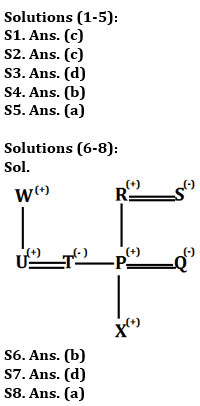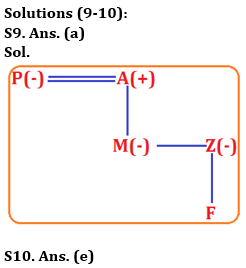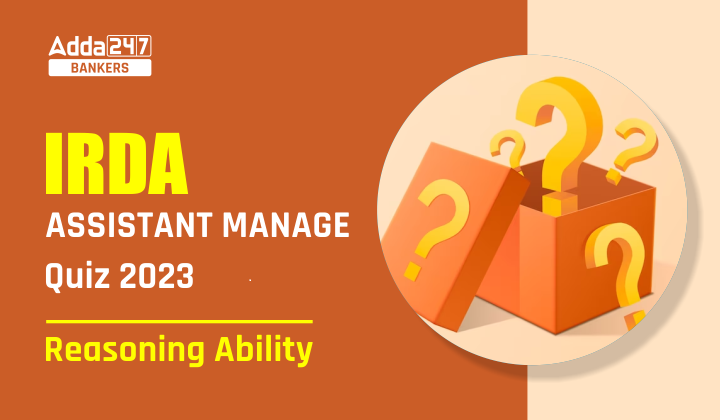Directions (1-5): Study the following sequence and answer the given questions.
A @ 3 % 4 E N M $ 8 & 6 L D S ♠ 9 8 6 Q Y Z 1 7 % R O G ⧫ 2 I B 2 U &
Q1. Which of the following element is twelfth to the left of the twentieth element from the left end of the given arrangement?
(a) 6
(b) &
(c) M
(d) $
(e) None of these
Q2. If all the symbols are dropped from the series, which element will be fourth to the right of the one which is twelfth from the right end?
(a) 9
(b) O
(c) R
(d) 7
(e) None of these
Q3. How many such numbers are there in the given series which are immediately preceded by a symbol and followed by a letter?
(a) None
(b) One
(c) Two
(d) Three
(e) Four
Q4. Four of the following five are alike in a certain way and forms a group, find the one that does not belong to that group?
(a) 3E%
(b) R⧫2
(c) M&$
(d) D9S
(e) Y7Z
Q5. What should come in place of question mark (?) in the following series based on the above arrangement?
34% N$M 6DL 8Q6 ?
(a) %OR
(b) 7Z%
(c) O%R
(d) R%O
(e) R%7
Direction (6-8): Study the following information carefully to answer the given questions.
Eight Persons P, Q, R, S, T, U, W and X in a family. There are three married couple. T is sister P. R is grandfather of X. W is father of U. Q is daughter in law of S who is not married to W. X is unmarried male and T is married to U who has no child.
Q6. Who among the following is nephew of T?
(a) R
(b) X
(c) S
(d) Q
(e) None of these
Q7. Who among the following is son in law of S?
(a) P
(b) X
(c) R
(d) U
(e) None of these
Q8. What is the relation of Q with X?
(a) Mother
(b) Aunt
(c) Grand-Mother
(d) Sister
(e) Wife
Directions (9-10): Study the following information carefully and answer the questions which follow:
‘M + K’ means ‘M is brother of K’
‘M ÷ K’ means ‘M is father of K’
‘M × K’ means ‘M is wife of K’
‘M – K’ means ‘M is sister of K’
‘M = K’ means ‘M is mother of K’
Q9. In expression ‘P × A ÷ M – Z = F’, how is F related to P?
(a) Grandchild
(b) Grandson
(c) Grand daughter
(d) Grandmother
(e) Son
Q10.Which of the following expression represents the relationship ‘D is daughter – in – law of C’?
(a) D × H + N = E ÷ C
(b) H + D × N ÷ E = C
(c) C = F + L – Z × D
(d) C × F ÷ L ÷ Z × D
(e) None of these
Directions (11-15): In these questions, a relationship between different elements is shown in the statements. The statements are followed by two conclusions. Give answer
Q11. Statement: A>B; G<D≤E; G≥F>B
Conclusion: I. G≥A II. B<E
(a) if only conclusion II is true.
(b) if only conclusion I is true.
(c) if neither conclusion I nor II is true.
(d) if either conclusion I or II is true.
(e) if both conclusions I and II are true.
Q12. Statement: A>T≥J; A≤S=H; I>T
Conclusion: I. H>J II. I>S
(a) if both conclusion I and II are true.
(b) if only conclusion I is true.
(c) if neither conclusion I nor II is true.
(d) if either conclusion I or II is true.
(e) if only conclusion II is true.
Q13. Statement: J≥K>L<M≥N; K≥O=T
Conclusion: I. J>O II. J=T
(a) if only conclusion II is true.
(b) if either conclusion I or II is true.
(c) if neither conclusion I nor II is true.
(d) if only conclusion I is true.
(e) if both conclusions I and II are true.
Q14. Statement: A> T=N; A>S>R; A<M
Conclusion: I. R<T II. N≤R
(a) if only conclusion II is true.
(b) if only conclusion I is true.
(c) if neither conclusion I nor II is true.
(d) if either conclusion I or II is true.
(e) if both conclusions I and II are true.
Q15. Statement: A<B≤C; F<M≤C; C>Q
Conclusion: I. Q≤F II. F>Q
(a) if only conclusion II is true.
(b) if either conclusion I or II is true.
(c) if neither conclusion I nor II is true.
(d) if only conclusion I is true.
(e) if both conclusions I and II are true.
Solutions


Solutions (11-15):
S11. Ans.(a)
Sol. I. G≥A(False) II. B<E(True)
S12. Ans.(b)
Sol. I. H>J(True) II. I>S (False)
S13. Ans.(b)
Sol. I. J>O(False) II. J=T (False)
S14. Ans.(d)
Sol. I. R<T(False) II. N≤R(False)
S15. Ans.(c)
Sol. I. Q≤F (False) II. F>Q(False)





 GA Capsule for SBI Clerk Mains 2025, Dow...
GA Capsule for SBI Clerk Mains 2025, Dow...
 The Hindu Review October 2022: Download ...
The Hindu Review October 2022: Download ...
 30 Days Study Plan to Crack SBI Clerk 20...
30 Days Study Plan to Crack SBI Clerk 20...





